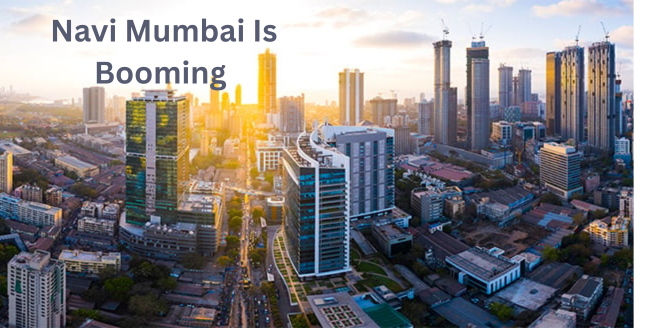Why Navi Mumbai Is Booming
Read latest blogs and articles from Housystan

The Information mentioned here was last updated on:
28/11/2025Navi Mumbai, once seen simply as an extension of Mumbai, has now grown into a major urban center with its own identity, rhythm, and economic force. Over the last decade, it has transformed from a quiet satellite city into one of the fastest-growing regions in India. The boom is visible everywhere new businesses, real estate growth, better roads, and a steady rise in population. While many Indian cities struggle with overcrowding and weak infrastructure, Navi Mumbai has taken a different path, shaped by planned development and modern facilities that make it an increasingly attractive place to live and work.
One of the biggest reasons behind this rapid growth is planned urban development. Unlike traditional cities that grow without structure, Navi Mumbai was designed from the ground up. The city’s layout, zoning, and utilities were all planned by CIDCO (City and Industrial Development Corporation of Maharashtra), which ensured organized neighborhoods, wide roads, green zones, and efficient distribution of public services. This planned design prevents many of the issues that older cities face—traffic chaos, cramped roads, and inconsistent civic systems. As a result, residents enjoy smoother commutes, cleaner surroundings, and better access to essential services.
- Verified Tenants/Buyers
- Unlimited Property Listing
- Zero subscription/charges fee
Another major factor driving Navi Mumbai’s rise is its connectivity. The region is linked to Mumbai and other nearby cities through important routes like the Sion-Panvel Highway, Palm Beach Road, Mumbai-Pune Expressway, and Thane-Belapur Road. The suburban railway network also connects Navi Mumbai to the larger Mumbai Metropolitan Region, making it easier for thousands of people to travel for work each day. In recent years, transport upgrades have made the city even more reachable. The new Navi Mumbai Metro is rolling out in phases, promising faster local travel and easing road congestion. These improvements make the city more appealing for both businesses and residents who want smooth movement without the stress of long, unpredictable travel times.
A turning point in Navi Mumbai’s growth story is the Navi Mumbai International Airport, one of the most ambitious infrastructure projects in the country. Even before becoming fully functional, the airport has already triggered economic excitement. Real estate prices around Panvel, Ulwe, and Dronagiri have witnessed steady increases as companies and homeowners anticipate a surge in commercial activity. The airport is expected to position Navi Mumbai as a major hub for trade, logistics, hospitality, and global travel. For investors and businesses, this opens doors to new opportunities, creating a ripple effect of growth across industries.
Real estate is one of the clearest signs of Navi Mumbai’s boom. Demand for housing has increased as more people choose the city for its affordability compared to Mumbai and its modern lifestyle advantages. Neighborhoods like Kharghar, Vashi, Nerul, and Seawoods have become hotspots for residential buyers. The presence of educational institutions, shopping centers, corporate offices, and healthcare facilities creates a balanced urban environment. Developers are responding with new projects that offer better amenities, spacious homes, and cleaner surroundings—features that are becoming harder to find in crowded metropolitan areas. With rising demand from families, professionals, and investors, Navi Mumbai’s real estate market continues to expand at a steady pace.
The city’s job market is also a major contributor to its expansion. Navi Mumbai has grown into a business and IT hub, especially in areas like Vashi, Airoli, and Mahape. The Maharashtra Industrial Development Corporation (MIDC) zone in Mahape hosts a large number of tech firms, startups, and manufacturing units. Companies prefer Navi Mumbai for its lower operating costs, reliable infrastructure, and convenient access to transport networks. As more companies move in, job opportunities continue to increase, drawing skilled workers from across the country. This, in turn, supports growth in housing, retail, and local businesses, creating a cycle of rising economic activity.
Lifestyle improvements also play a major role in making Navi Mumbai appealing. The city is known for being cleaner and less crowded than Mumbai. It offers wide open spaces, well-maintained parks, and recreational spots like waterfronts and nature trails. Places such as the Kharghar Valley Golf Course, Central Park, and Wonders Park provide leisure options for residents of all age groups. With shopping malls, restaurants, educational institutions, and sports facilities, the quality of life here feels more balanced and less rushed. Families often find the environment ideal for raising children, while young professionals enjoy the modern amenities.
Another element supporting the city’s expansion is the presence of large educational and healthcare facilities. Navi Mumbai is home to reputable schools, colleges, and universities that attract families from different regions. Its hospitals both public and private offer reliable care, which adds to the overall sense of security for residents. The availability of such essential services reduces the need to travel to Mumbai for education or medical treatment, strengthening Navi Mumbai’s position as a self-sufficient city.
Sustainability has also been an important part of its development model. The city has maintained good levels of greenery and open spaces, something rare in big cities. Efforts toward waste management, water conservation, and preserving natural areas like mangroves have helped keep the environment healthier. This emphasis on green development adds to the city’s long-term appeal and supports a more comfortable lifestyle.
As Navi Mumbai moves forward, its growth trajectory shows no signs of slowing down. With ongoing projects, strong infrastructure, a growing job market, and solid residential appeal, the city has become one of India’s most promising urban centers. Its rise reflects what modern city building can achieve when planned with foresight, efficiency, and a focus on improving everyday life for people.